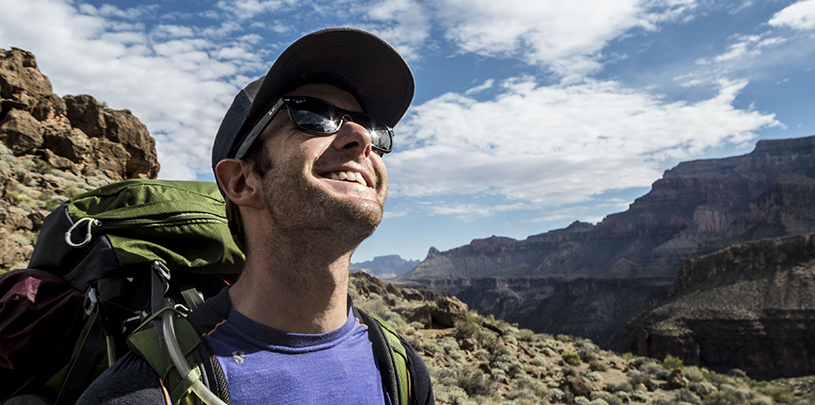
 by Ellen Heyn, Communications Manager
by Ellen Heyn, Communications Manager
There are thousands of adjectives that describe the Grand Canyon — majestic, breathtaking, awe-inspiring. Friendly is not on the list. The Grand Canyon is a landscape of sharp edges, armored plants, and poisonous critters. Temperatures are extreme; water is scarce.
The elements have shaped the Grand Canyon into what it is today, but they’ve also caught many a hiker underprepared and ill-equipped. Backpacking and hiking in the canyon require standard gear that’s probably already in your closet. But the steep, loose, rocky, poky, hot, dry, and unforgiving nature of the terrain warrants some additional considerations when hiking in Grand Canyon National Park.
Let’s start with the basics. Just want a list? Find a packing checklist here ›

National Park Service
In the Grand Canyon, a vertical mile of rock stands between you and your most reliable water source: the Colorado River. Knowing where you can find water and how much you need to carry between sources is crucial for any trip. Come up short and you’re looking at a deadly case of cotton mouth.
It depends. Your water calculation varies based on your route, how many miles you’re hiking, the season, where you can refill, and how acclimatized you are to the desert. At a minimum, plan to carry 3 liters a day, and considerably more if you’re dry camping.
The only spigots you’ll find in the Grand Canyon are along the Bright Angel and North Kaibab trails. Otherwise, you’re looking at springs (some seasonal) and the Colorado River as your primary water sources.
Note: The Bright Angel pipeline often breaks. Before you hike, check the trail board to see what spigots are turned on along those trails, and plan accordingly.
All natural water sources need to be treated. The Colorado River and its tributaries occasionally run muddy, rendering drops or UV wands useless. Real filters — the kind that force water through a physical barrier — work better for the river’s chocolate-milk conditions (more common July through September). You might want to consider bringing a bandana and an extra vessel to strain out sediment prior to filtering. Alum, which you can find in the spice aisle at your grocery store, when mixed in muddy water, will also help particles settle.
Having additional water-carrying capacity is crucial for backpacking. Some days you’ll need two liters, and other days six. Collapsible water bottles are the perfect solution — light and compact when you don’t need them, and lifesavers when you do. Bring enough vessels to cover your maximum daily water needs, plus an extra liter.

Plants are sharp in the Grand Canyon. Avoid prickly predicaments with these tips.
Hiking in the Grand Canyon is the perfect recipe for blisters — it’s a million degrees, your feet sweat and swell, and the trails are sandy. Don’t get caught without blister supplies (bandages, ointment, tape, moleskin, dry socks, etc.), and be proactive about taking care of your feet.
Footwear options range from traditional hiking boots to trail-runners. Just make sure they’re broken-in before you drop into the canyon (the Grand Canyon is NOT the place to try new shoes). And to state the obvious: high heels are entirely unsuitable for the Grand Canyon. The things we've seen on the Bright Angel Trail...
Descending a vertical mile in poorly fitting shoes can cause mega toe jams. Be sure to trim your toenails before hiking to prevent hours of painful pounding downhill.
You know what’s way easier than carrying a big bottle of sunscreen and remembering to continuously reapply? Covering up! Long-sleeved shirts, long pants, and hats are keys to comfortable Grand Canyon trekking.
What you pack for meals and snacks is personal preference, but make sure you bring enough salty foods. You’ll sweat more than you realize, and you need to recharge with salts and electrolytes. Indulge at the chip aisle when grocery shopping for your trip! (Pringles and peanut butter-filled pretzels, anyone?)
Drinking too much water is a thing. Drink frequently, but make sure you’re eating food throughout the day to balance water intake.
We all love chocolate, but a hot day can turn the candy bar in your pack into a melted puddle of goo. If you want to avoid the mess, stick with M&Ms instead.
Rattlesnakes, scorpions, and venomous insects certainly deserve caution, but it’s the squirrels, ravens, and mice that you’ve got to watch out for. They chew through packs, open zippers, and steal your food if you’re not careful.
The downside of desert backpacking is carrying an extra 10 pounds of water. The upside? There’s a good chance you can leave your tent at home.
Sleeping beneath a ribbon of stars, tucked in the bottom of the Grand Canyon, is magical. Especially when you don’t have a rainfly or mesh veil obstructing your view. That said, it occasionally rains in the desert, so you should check the forecast before ditching your shelter.
Note: Disregard our tent-free plug from July to mid-September. Monsoon storms reliably roll through the Southwest during the summer months.
Hammock camping is great — assuming there are trees to string up your hammock. But trees in the Grand Canyon are few and far between. You might find some cottonwoods along creeks, but tamarisk and Russian olives are the dominant vegetation along the river corridor and not particularly hammock friendly. Most campsites are on beaches or bare rock. Free-standing tents tend to work the best (the hard ground bends stakes), but there are usually plenty of rocks around if you need to get creative.
Don't let a little snow keep you from visiting the Grand Canyon. Here's everything you need to know for a winter trip to the big ditch.
Read MoreFind out where to camp beneath the stars in and around Grand Canyon National Park.
Read MoreSettle in to see one of the most awe-inspiring landscapes in the world transform under an expansive, colorful sky.
Read More